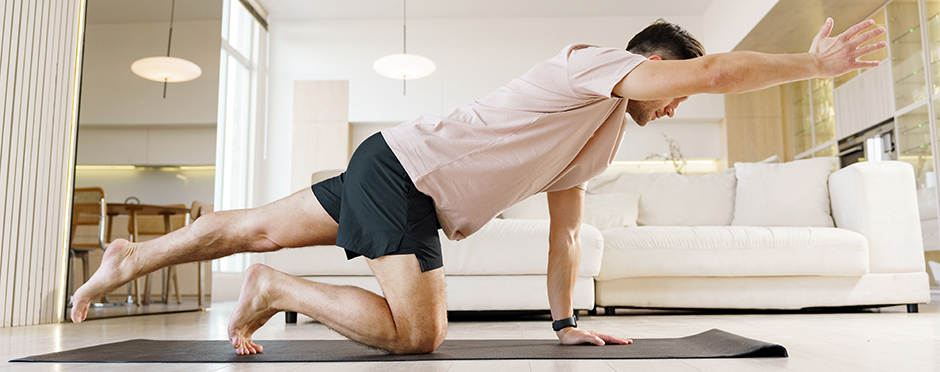
A Guide to a Bullet Proof Core for Overhead Athletes
Leave a CommentWhile overhead sports rely heavily on our upper extremities (shoulders, elbows, and wrists), the core is often forgotten as a critical piece of the puzzle for success in sports with a high overhead demand. Many facets of the core contribute to overhead movements and strength. The core stabilizes the body from the legs up. Because the shoulder is a less stable joint by itself, maintaining a strong core is important for athletes such as pitchers and throwers.
The core consists of many different muscle groups and works in various directions.
Deep core stabilizers – multifidus, pelvic floor, transverse abdominus, and diaphragm
The multifidus, pelvic floor, transverse abdominus (TA), and diaphragm are muscles that stabilize the spine and absorb force from the ground and gravity. Strengthening these muscles without compensating takes very accurate cueing and activation.
- Multifidus: Lie on your back with one knee bent. GENTLY press your bent knee onto the floor/bed and hold for 5 seconds.
- Transverse abdominus: Lie on your back with your knees bent. Use two fingers to find your hip bones in the front on both sides, then move your fingers in 1 inch and down 1 inch – this will be where you can feel the TA activate. GENTLY draw your belly button in and up 1 cm – you will feel the muscle under your fingers press into your fingers or flatten out.
- Pelvic floor: Perform this in any position. GENTLY activate the muscles you would use if you were trying to stop the urine flow and relax completely on your way out.
- Diaphragm: This can also be performed in any position., Place one hand on your chest and one hand on your belly. Take a deep breath and fill your belly with air (your chest should barely move), then release the breath.
Outer core – rectus abdominus, external obliques, lumbar paraspinals
The term “cross slings” is utilized when describing the functional components related to the core2. These muscles wrap across the body on the front and the back to provide functional stability with day-to-day activities.
Core exercise and strength while performing movements similar to your activities are critical for success in overhead sports. Core exercises for overhead athletes help improve performance in sports and prevent injury from occurring during the sport. Here are some exercises for overhead athletes to try that can support a stronger outer core:
- Side planks: This exercise will work all aspects of the core. When performing a plank, no matter the direction, make sure to push up through the shoulder and keep the knees/toes in contact with the floor. Squeeze your glutes and keep your hips up. You can add weight or different activities to the arm in the air for more challenge.
- Chops: Kneel down on one knee. Using a band, pull the band from a higher level to your hip or from your hip to the higher level – these can be performed across the body or pulling away from the body.
- Bird dogs: On your hands and knees, make sure your back is flat. Reach out with your hand and opposite leg without moving your trunk, alternating sides. Add a resistance band to your arms, legs, or both for more challenge.
- Suitcase carries: While holding a heavy weight in one hand (either at your side or overhead for more challenge), perform a marching walk, pausing for one second with your knee elevated and maintaining a stable pelvis.
- Pallof press: You will anchor a band to the wall and stand perpendicular to the wall. Standing nice and tall, pulling your shoulders back, and holding a band at your chest level, you will press the band forward without rotating and hold for 3 seconds. To make this more challenging, you can also add a banded sidestep prior to the press.
- Medicine ball toss: Medicine ball tosses can be performed in any direction – you can throw the ball sideways, slam down towards the floor, etc. To make this more challenging, you can also change the surface you are standing on or perform exercises on one leg.
If you notice abnormal soreness, aches, or pains with your current training program or want help getting a training program started, contact one of our Overhead Athlete specialists at Athletico. Our team will assess your pain and provide recommendations for a treatment plan.
*Per federal guidelines, beneficiaries of plans such as Medicare, Medicaid, Tricare, VHA and other federally funded plans are not eligible for free assessments.
The Athletico blog is an educational resource written by Athletico employees. Athletico bloggers are licensed professionals who abide by the code of ethics outlined by their respective professional associations. The content published in blog posts represents the opinion of the individual author based on their expertise and experience. The content provided in this blog is for informational purposes only, does not constitute medical advice and should not be relied on for making personal health decisions.
References:
1. 3 Exercise to Develop Rotational Power in Baseball Players – Elite Baseball Performance
2. https://theprehabguys.com/oblique-sling-exercise-progressions/
